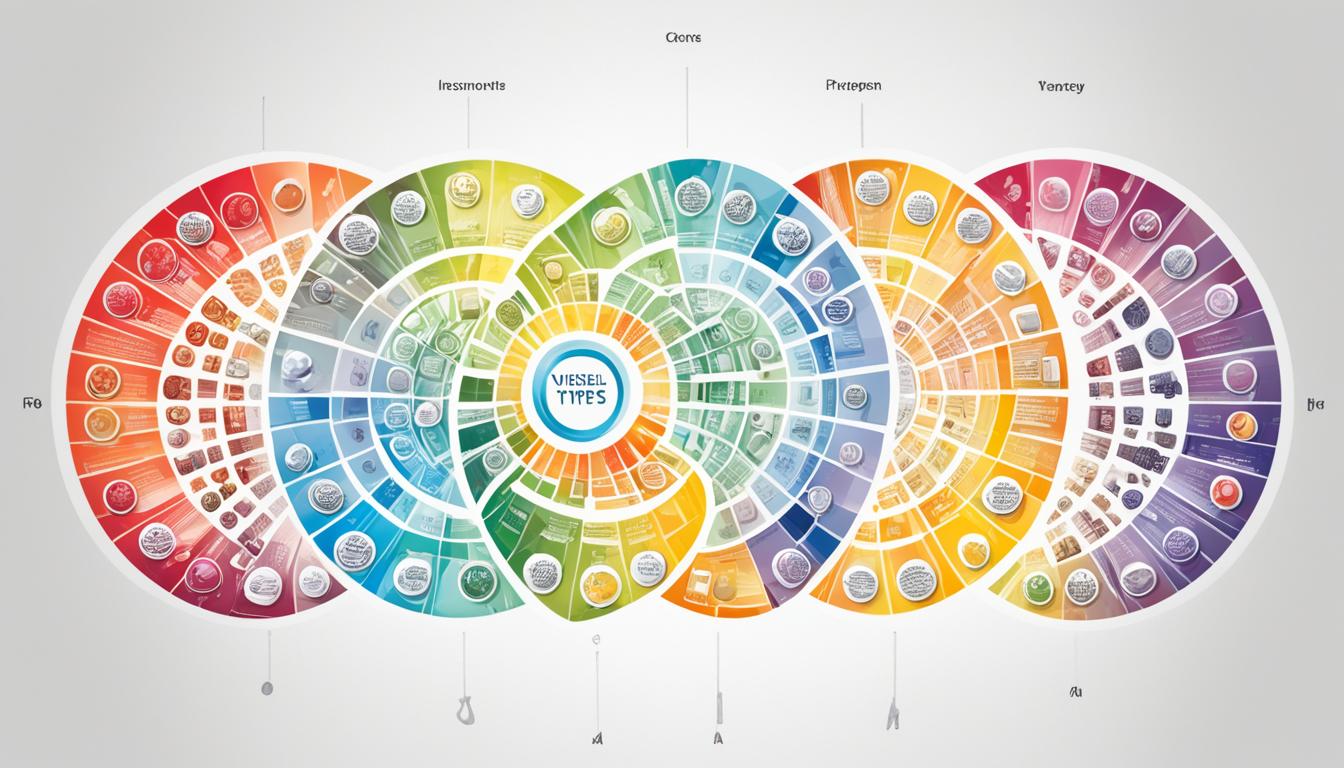Were you aware that the Alpha Beta Omega Personality Test has become incredibly popular for classifying people into three unique personality categories? Absolutely! Drawing inspiration from animal behavior research, particularly regarding wolves, this test is a tool for individuals to identify their prevailing personality traits and their manner of relating to others within social environments.
Key Takeaways:
- The Alpha Beta Omega Personality Test categorizes individuals into three distinct personality types: Alpha, Beta, and Omega.
- The test is based on the concept of social hierarchy derived from animal behavior studies.
- Alpha personalities are confident, assertive, and natural leaders.
- Beta personalities are empathetic, thoughtful, and supportive team players.
- Omega personalities are introverted, eccentric, and embrace their uniqueness.
What is the Alpha Personality Type?
The alpha personality type is characterized by traits such as confidence, assertiveness, and natural leadership abilities. Alphas are often seen as the dominant individuals in social groups and are not afraid to take charge or make decisions. They exude a sense of self-assuredness and tend to excel in their careers. Alphas are typically strong-willed and strive to be the best at what they do.
If we were to describe an alpha, they would be someone with a commanding presence, someone who takes control of situations effortlessly. They are confident in their abilities and often possess a strong sense of self. Alphas are natural leaders who thrive in positions of authority, inspiring and motivating others to follow their lead.
“Alphas have a unique ability to take charge and make decisions. They have a strong presence and are not afraid to assert themselves in various settings.”
In social settings, alphas are typically the ones who take the lead, initiating conversations and taking control of group dynamics. Their assertiveness and strong-willed nature make them influential figures who can leave a lasting impact on those around them. Alphas often excel in competitive environments or high-pressure situations where their confidence and ability to make quick decisions can be valuable assets.
Understanding the characteristics of an alpha personality type is essential in recognizing our own strengths and areas for growth. It can help us navigate social dynamics and develop our leadership skills. However, it is important to remember that alpha traits exist on a spectrum, and everyone possesses a unique blend of personality characteristics.
Exploring the Beta Personality Type
In our previous section, we discussed the alpha personality type, known for its confidence and natural leadership abilities. Now, let’s shift our focus to another personality type within the alpha beta omega spectrum – the beta. While betas may not possess the assertiveness of alphas, they play a crucial role in social dynamics, bringing valuable qualities to the table.
The beta personality type is characterized by traits such as empathy, thoughtfulness, and attention to detail. Betas are often supportive team players who excel in areas that require careful planning and consideration. While alphas may take charge, betas provide the steady support and cooperation needed for group success.
“Betas are more focused on others’ needs and can be highly empathetic.”
– Quote from a beta personality test participant
What sets betas apart is their ability to prioritize the needs and well-being of others. They excel in their capacity to listen, understand, and respond compassionately. Betas often have a keen sense of observation and pay attention to the details that others may overlook. Their thoughtfulness fosters stronger relationships and deeper connections, allowing them to build trust with those around them.
Being a beta does not mean being weak or lacking in capability. In fact, betas possess remarkable strengths that complement the qualities of alphas. While alphas may lead, betas are the supportive backbone that helps drive collective achievements and create a harmonious environment. They excel in tasks requiring organization, planning, and coordination.
“Betas bring invaluable qualities to any team or social setting, ensuring the needs of all are met and fostering a sense of unity.”
– Quote from a beta personality test participant
The Beta Personality Traits:
| Personality Traits | Description |
|---|---|
| Empathy | Betas have a strong ability to understand and relate to the emotions and experiences of others. |
| Thoughtfulness | Betas are attentive to details and considerate in their actions and decisions. |
| Supportive | Betas provide stability and cooperation, offering support to those around them. |
| Planning and Coordination | Betas excel in organizing and coordinating tasks, ensuring smooth execution. |
Understanding the beta personality type is crucial for comprehending the complex dynamics within social groups. By acknowledging the strengths and characteristics of betas, we can foster an inclusive environment where every personality type is valued and appreciated.

Understanding the Omega Personality Type
The omega personality type is characterized by introversion, eccentricity, and a unique perspective on life. Omegas may struggle with social interactions and often do not conform to traditional social hierarchies. They tend to be more individualistic and may excel in creative or unconventional fields. Omegas are seen as free spirits who are unafraid to be different and embrace their uniqueness.

Key Traits of the Omega Personality Type
- Introverted: Omegas are often more comfortable in their own company and prefer solitude over large social gatherings.
- Eccentric: They have a penchant for unique and unconventional ideas and behaviors.
- Non-Conformist: Omegas resist societal norms and expectations, choosing to follow their own path.
- Creative: They possess a natural inclination towards artistic expression and thinking outside the box.
- Unafraid to be Different: Omegas embrace their individuality and often challenge the status quo.
In our society, the omega personality type is sometimes misunderstood or marginalized due to their unconventional nature. However, it is important to recognize and appreciate the valuable perspectives and contributions that omegas bring to our world.
While traditional social hierarchies may not value the omega personality type as highly, their unique qualities often lead to important innovations, artistic creations, and alternative ways of thinking. Omega individuals may have a profound impact on society by pushing boundaries and encouraging others to question the status quo.
Examples of Famous Omega Personalities
| Personality | Field |
|---|---|
| Salvador Dalí | Art |
| Emily Dickinson | Literature |
| Nikola Tesla | Science |
These individuals challenged societal norms, made groundbreaking contributions in their fields, and left a lasting impact on the world.
Understanding the omega personality type allows us to appreciate the diversity of human personalities and the valuable perspectives that each individual brings. By embracing individuality and fostering an inclusive and accepting society, we can create a world that values and celebrates the unique qualities of all personality types.
Taking the Alpha Beta Omega Personality Test
Are you curious to uncover your social archetype and gain insight into your dominant personality traits? Look no further than the Alpha Beta Omega Personality Test, a free online assessment that can help you understand how you interact with others in social settings. By answering a series of thought-provoking questions, you’ll gain valuable self-awareness and discover your place within the alpha beta omega spectrum.
Available on various popular platforms, including BuzzFeed and Uquiz, the Alpha Beta Omega Personality Test offers an engaging and entertaining way to explore your personality traits. Whether you’re an alpha, beta, or omega, this test provides a deeper understanding of your behavior, preferences, and reactions in different scenarios.

Take a moment to reflect on your personality and the characteristics that define you. Are you a natural-born leader, a supportive team player, or a unique individual with a different perspective on life? The Alpha Beta Omega Personality Test will help you uncover these traits and provide valuable insights into your social interactions.
Remember, the test is not a definitive label but serves as a tool for self-exploration and personal growth. Embrace your individuality and challenge any stereotypes that may restrict your understanding of yourself. Personality types can be fluid, evolving over time based on personal experiences and growth.
The Significance of Alpha, Beta, and Omega in Social Dynamics
The concept of alpha, beta, and omega personality types originated from studies on animal behavior, particularly wolves. In social hierarchies, the alpha is the dominant individual who holds authority and leads the pack. The beta is a supportive member of the group who contributes to its functioning. The omega is often the most submissive and lowest-ranking member. While these classifications are commonly applied to human behavior, it is essential to recognize that human social dynamics are more complex and influenced by various factors.
Social hierarchies exist in many species, including wolves, where they play a crucial role in maintaining order and cooperation within groups. The alpha wolf, for example, leads the pack, making decisions and ensuring the group’s survival. Alphas are typically strong, confident, and assertive individuals who command respect and authority.
The beta personality type serves as a key support system within the social hierarchy. Betas are often empathetic, thoughtful individuals who contribute to the group’s well-being. They are team players, fostering collaboration and aiding in decision-making processes.
The omega personality type is the lowest-ranking member in the social hierarchy. These individuals are often more submissive and introverted, preferring to avoid conflict and conform to the group’s dynamics. While omegas may not hold positions of leadership or dominance, they offer unique perspectives and contribute to the diversity within social groups.
It is important to note that human social dynamics are influenced by a range of factors, including cultural, societal, and individual contexts. While the alpha, beta, and omega personality types provide a framework for understanding social hierarchies, they do not fully capture the complexities of human behavior. Each person possesses a unique blend of traits and characteristics that cannot be neatly categorized.
Understanding the Alpha Personality Type
The alpha personality type is characterized by confidence, assertiveness, and natural leadership abilities. Alphas are often seen as dominant individuals in social groups and are not afraid to take charge or make decisions. They exude a sense of self-assuredness and tend to excel in their careers. Alphas are typically strong-willed and strive to be the best at what they do.
Exploring the Beta Personality Type
The beta personality type is identified by qualities such as empathy, thoughtfulness, and attention to detail. Betas may not possess the same level of assertiveness as alphas, but they play a vital role in social dynamics. They are often supportive team players who excel in areas that require careful planning and consideration. Betas are more focused on others’ needs and can be highly empathetic.
Understanding the Omega Personality Type
The omega personality type is characterized by introversion, eccentricity, and a unique perspective on life. Omegas may struggle with social interactions and often do not conform to traditional social hierarchies. They tend to be more individualistic and may excel in creative or unconventional fields. Omegas are seen as free spirits who are unafraid to be different and embrace their uniqueness.

| Personality Type | Traits |
|---|---|
| Alpha | Confident, assertive, natural leadership abilities |
| Beta | Empathetic, thoughtful, attention to detail |
| Omega | Introverted, eccentric, unique perspective |
Differentiating Personality Types in the Alpha Beta Omega Spectrum
Within the alpha beta omega spectrum, there are further differentiations that can provide in-depth insights into an individual’s personality traits. One such distinction is the sigma male personality type, which is often associated with independence, introversion, and a preference for functioning outside the traditional social hierarchy.
Online personality tests offer valuable tools for self-reflection and understanding. They can provide additional categorizations and delve deeper into an individual’s personality traits beyond the basic alpha, beta, and omega classifications. These tests allow individuals to gain a better understanding of themselves and how they interact with others in social settings.
Role of Online Personality Tests
Online personality tests have gained popularity as a means of self-assessment and personal growth. These tests enable individuals to explore their dominant personality traits and evaluate how they can impact their interactions with others. By offering detailed insights into various personality types within the alpha beta omega spectrum, these tests can facilitate a deeper self-understanding.
“Personality tests can provide additional categorizations and delve deeper into an individual’s personality traits beyond the basic alpha, beta, and omega classifications.”
Guided by the results of these tests, individuals can identify their strengths, weaknesses, and potential areas for personal development. Whether you seek to understand your leadership potential as an alpha, your empathetic nature as a beta, or your uniqueness as an omega, online personality tests can offer valuable insights that contribute to personal growth and self-improvement.
| Personality Type | Key Traits |
|---|---|
| Alpha | Confidence, assertiveness, natural leadership abilities |
| Beta | Empathy, thoughtfulness, attention to detail |
| Omega | Introversion, eccentricity, unique perspective on life |
| Sigma | Independence, introversion, operating outside traditional hierarchy |
Keep in mind that while these tests provide useful insights, it’s crucial to approach them critically and use the results as a starting point for self-exploration and growth. Personality assessments should never define or limit an individual; instead, they serve as tools for personal reflection and understanding.

Exploring Social Hierarchy and Personality Dynamics
Social hierarchy and personality dynamics are vital aspects of our lives, influencing our relationships, work environments, and social interactions. Understanding where we fall within the alpha beta omega spectrum can provide valuable insights into navigating these dynamics effectively. Factors such as confidence, assertiveness, empathy, and individuality contribute to how we interact within a social hierarchy.
Alpha Male Test
To determine if you possess alpha male characteristics, you can take an alpha male test. This test assesses traits such as confidence, leadership, and assertiveness. It helps identify if you embody the alpha male persona. However, it’s important to remember that personality is multifaceted, and no test can provide a definitive assessment.
Beta Male Characteristics
Beta males are often described as nurturing, empathetic, and supportive individuals. They may not possess the same level of dominance as alphas but play an important role in building and maintaining social connections. Beta male characteristics include being considerate, adaptable, and team-oriented.
Omega Male Characteristics
Omega males are often unconventional, introverted, and independent individuals. They may challenge traditional social norms and hierarchies, embracing their uniqueness. Omega male characteristics include creativity, individuality, and a non-conformist mindset.
To gain further clarity on your personality traits within the alpha beta omega spectrum, you can explore an alpha beta omega quiz on platforms like Playbuzz. These quizzes provide a fun and interactive way to assess your personality alignments and gain insights into your social dynamics.

The Influence of Nature vs. Nurture on Personality Types
The development of personality types is a complex interplay between nature and nurture. While certain innate traits may predispose individuals to exhibit alpha, beta, or omega characteristics, environmental factors and upbringing also play a crucial role in shaping personality.
It is important to understand that personality types are not fixed and can evolve over time. Personal experiences, growth, and self-reflection contribute to the development and refinement of one’s personality.
“Personality traits are like seeds waiting to be nurtured by the right environment. The combination of our genetic makeup and the influences we are exposed to shape who we become.”
Both nature and nurture influence the expression of alpha, beta, and omega traits in individuals. While genetics may provide a foundation, environmental factors such as family dynamics, cultural background, education, and social interactions further mold and shape personality.
The Role of Nature
Our genetic makeup lays the groundwork for our personality traits. Certain genetic factors may influence aspects such as temperament, disposition, and predispositions toward certain behaviors.
For example, research suggests that individuals with specific genetic variations may be more likely to exhibit dominant characteristics associated with alpha personalities. Similarly, genetic factors may contribute to traits such as empathy and sensitivity, commonly attributed to beta personalities.

The Power of Nurture
While genetics may provide a starting point, the environment in which we grow and develop has a profound impact on our personality formation.
Family dynamics, upbringing, cultural influences, peer interactions, and life experiences all shape our behavior and the way we engage with the world around us. These external factors contribute to the nurturing and refining of our personality traits.
“Our environment fuels the growth of our personality, offering opportunities for personal development, learning, and adaptation to different situations.”
For example, individuals raised in nurturing and supportive environments may develop characteristics associated with beta personalities. On the other hand, an individual who has faced adversity or challenges may develop resilience and independence, traits often associated with omega personalities.
The Dynamic Nature of Personality
It is important to emphasize that personality types are not static or predetermined. Through self-reflection, personal growth, and the acquisition of new experiences, individuals have the ability to transform and evolve their personality traits.
While personality tests like the Alpha Beta Omega test on Omegaverse or Quotev and other similar omega quizzes can provide insights into one’s dominant personality traits at a specific point in time, they are not definitive or exhaustive indicators of an individual’s entire personality profile.
“We are not bound by the confines of a single personality type. Our personalities are intricate and multifaceted, capable of growth, change, and adaptation throughout our lives.”
It is valuable to recognize the fluidity of personality and embrace the potential for personal development and self-improvement. By continuously learning, reflecting, and embracing new experiences, individuals can shape their personalities and redefine their identity within the alpha beta omega spectrum.
The Impact of Personality Types on Social Interactions
Our personality type influences how we interact with others and shapes the dynamics within relationships. Whether you identify as an alpha, beta, or omega, your unique traits and tendencies play a significant role in shaping your social interactions. Let’s explore how each personality type impacts communication, collaboration, and relationship dynamics.
The Alpha Personality Type and Social Interactions
Alphas, known for their confidence and assertiveness, often take charge and lead in social settings. They have a natural inclination to lead and make decisions. Alphas exude self-assuredness and strive to be the best. Their dominant personality traits can inspire and motivate others to follow their lead.
The Beta Personality Type and Social Interactions
Betas, characterized by empathy, thoughtfulness, and attention to detail, excel in supporting roles. They are often skilled at building relationships and provide the emotional support that others may need. Betas contribute to group dynamics by fostering collaboration and creating a harmonious environment.
The Omega Personality Type and Social Interactions
Omegas bring unique perspectives to social interactions. They tend to challenge traditional norms and possess a strong sense of individuality. While they may struggle with social interactions, omegas can offer fresh insights and unconventional solutions to problems. Their creativity and willingness to question the status quo can inspire others to think outside the box.
Understanding the impact of personality types on social interactions allows us to navigate relationships more effectively. By embracing and appreciating the diverse range of alpha, beta, and omega traits, we can improve communication, collaboration, and foster healthy relationships.

| Personality Type | Characteristics |
|---|---|
| Alpha | Confident, assertive, natural leader |
| Beta | Empathetic, thoughtful, supportive |
| Omega | Introverted, eccentric, creative |
The Significance of Alpha, Beta, and Omega in Werewolf Lore
The concept of alpha, beta, and omega has also been applied to werewolf lore, adding an additional layer to the interpretation. In werewolf mythology, the alpha is typically the strongest and most dominant werewolf, leading the pack. The beta and omega werewolves play supporting roles within the hierarchy.
These archetypes add depth and complexity to werewolf tales and explore power dynamics within supernatural societies.

Unleashing the Power Within
Werewolf lore showcases the primal nature of humanity, delving into our deepest desires, fears, and the struggle for dominance. The alpha, with their immense strength and leadership qualities, represents our yearning for power and control. They are the embodiment of our innate desire to dominate and stand at the top of the social hierarchy.
The beta, on the other hand, symbolizes loyalty and support. As supporting characters, they exemplify the importance of teamwork and unity within a pack or society. Betas remind us that strength lies not only in individual abilities, but also in cooperation and collaboration.
The omega, often portrayed as the outcast or loner, offers a different perspective. They challenge conventions and societal norms, embracing their individuality and carving their own path. The omega represents the freedom to be different and authentic, regardless of the expectations placed upon them.
“In the realm of werewolf lore, the alpha, beta, and omega archetypes mirror the complexities of human nature, highlighting our universal desire for power, the value of teamwork, and the importance of embracing our individuality.”
Werewolf stories featuring alpha, beta, and omega dynamics tap into our fascination with the animalistic side of human nature. They serve as a vehicle to explore power struggles, loyalty, identity, and personal growth within a supernatural context.
The Werewolf Quiz
If you’re curious to discover which werewolf archetype you resonate with the most, you can take the Alpha Beta Omega Werewolf Quiz. This quiz will help unveil your inner wolf and provide insights into your personality traits. The quiz is free and available online, allowing you to connect with the primal forces that lie within.
Remember, werewolf lore taps into our primal nature and explores the depths of human existence. Whether you identify with the commanding presence of the alpha, the supportive nature of the beta, or the unconventionality of the omega, embrace the power that lies within you.
Embracing Individuality and Challenging Stereotypes
It is essential to recognize that individuals are not limited to fitting perfectly into one specific personality type category. Each person possesses a unique combination of traits and strengths that cannot be fully captured by simple categorizations. Embracing individuality and challenging stereotypes allows for a more comprehensive understanding and appreciation of the diverse range of human personalities.
Breaking the Mold
Traditional personality tests, such as the alpha beta omega test, strive to categorize individuals into rigid classifications. However, these classifications fail to capture the intricacies and nuances that make each person unique. It is important to remember that real-life personalities do not adhere to strict boundaries and are influenced by a multitude of factors.
In a society that often values conformity, it is empowering to embrace our individuality and challenge the limitations imposed by stereotypes. Rather than confining ourselves to predefined personality types, we should celebrate the rich tapestry of qualities and characteristics that make us who we are.
Resisting Limitations
The alpha beta omega sigma personality test, for example, is often used to categorize individuals based on their dominant traits. However, such tests overlook the fluidity and evolution of personality. People are not static beings; they grow, learn, and change over time.
In the words of renowned psychologist Carl Rogers, “The curious paradox is that when I accept myself just as I am, then I am free to change.” Embracing our true selves allows us to break free from the shackles of predetermined classifications and fosters personal growth.
In a similar vein, online personality tests like the alpha beta omega test buzzfeed aim to entertain rather than provide accurate assessments. While these tests can be enjoyable and provide some insights, it’s vital to approach them with a grain of salt. Instead of relying on external tests to define our identities, we should trust our own intuition and exploration of self.
Celebrating Diversity
Our unique personalities enrich society, foster innovation, and contribute to the vibrant tapestry of humanity. By embracing individuality and challenging stereotypes, we open ourselves up to a world of possibilities and foster a culture of acceptance and inclusivity.
The Role of Personality Tests in Self-Reflection
Personality tests offer valuable insights for self-reflection and personal growth. They provide a framework to understand our dominant personality traits and how they influence our interactions with others. Through self-reflection, we can gain a deeper understanding of ourselves and identify areas for personal development.
One such test is the Alpha Beta Omega Personality Test, which categorizes individuals into three distinct personality types: Alpha, Beta, and Omega. This test assesses our behavior, preferences, and reactions in various scenarios to determine our social archetype.
While personality tests like the Alpha Beta Omega Personality Test can be insightful, it is important to approach them with a critical mindset. They should be seen as a starting point for self-exploration rather than definitive labels. It’s essential to recognize that we are complex individuals with a unique combination of traits that can’t be fully captured by simple categorizations.
Self-reflection allows us to delve into our strengths and weaknesses, unlocking personal growth opportunities. By understanding our dominant traits, we can better navigate social interactions, improve communication, and build stronger relationships.
Exploring Dominant Personality Traits
Personality tests like the Alpha Beta Omega Personality Test help us identify our dominant personality traits. Here is a breakdown of the characteristics associated with each personality type:
| Personality Type | Characteristics |
|---|---|
| Alpha | Confidence, assertiveness, leadership abilities |
| Beta | Empathy, thoughtfulness, attention to detail |
| Omega | Introversion, eccentricity, unique perspective |
Understanding these dominant personality traits can provide valuable insights into how we interact with others and navigate social dynamics. It helps us recognize our strengths, areas for improvement, and areas where we can contribute effectively within a social hierarchy.
“Personality tests are like a mirror that reflects our dominant traits and challenges us to grow.”
Keep in mind that personality types are not fixed; they can evolve over time based on our experiences and personal growth. Embracing individuality and challenging stereotypes allows for a broader understanding and appreciation of the diverse range of human personalities.
In the next section, we will explore the fluidity of personality types and how they can fluctuate throughout life.
The Fluidity of Personality Types
Personality types are not fixed and can fluctuate throughout life. Individuals may display different characteristics depending on the context, personal growth, and evolving circumstances. This fluidity challenges the notion that individuals are solely confined to one specific personality type and highlights the complexity of human behavior and identity.
The Evolution of Personalities
Personality is a multifaceted aspect of human nature that develops and evolves over time. While individuals may exhibit certain traits that align with alpha, beta, omega, or other personality types, it is essential to recognize that these classifications are not absolute. Instead, personality is shaped by a combination of genetic predispositions, environmental influences, and personal experiences.
Throughout life, individuals may undergo significant personal growth, reflect on their behaviors, and adapt to new circumstances. As a result, their personality may shift and evolve, leading to changes in their dominant traits and tendencies. For example, an individual who was once an alpha may develop greater empathy and take on more beta-like characteristics as they mature.
The Influence of Context
Personality is not static; it is contextual. Different situations and environments can bring out different aspects of an individual’s personality. For instance, an alpha female may display strong leadership qualities and assertiveness at work, but exhibit more nurturing and empathetic traits in her personal relationships.
Additionally, the expectations and demands of different social settings can influence how individuals present themselves. An epsilon male, typically associated with more introverted and subordinate qualities, may embrace their leadership abilities and display more alpha-like characteristics in certain professional roles.
The Lambda Male Perspective
Another emerging concept in the realm of male personalities is the lambda male. The lambda male challenges traditional alpha-beta-omega dynamics by embracing individuality, rejecting hierarchical structures, and prioritizing personal happiness and authenticity. Lambda males are often characterized by their unique perspectives, non-conformity, and pursuit of unconventional lifestyles.
It’s important to note that the fluidity of personality types extends beyond traditional gender roles. Individuals of any gender identity can exhibit a range of traits and behaviors that may align with different personality types at various points in their lives.
Embracing Complexity and Diversity
Recognizing the fluidity of personality types allows for a more nuanced and comprehensive understanding of human behavior. It emphasizes the importance of individuality, personal growth, and acceptance of diverse personalities and perspectives.
Table: Examples of Personality Trait Shifts
| Initial Personality Type | Shift | Evolving Personality Type |
|---|---|---|
| Alpha | Becoming more empathetic and nurturing | Beta |
| Beta | Developing more assertiveness and leadership qualities | Alpha |
| Omega | Gaining more confidence and assertiveness | Alpha |
By embracing the complexity and fluidity of personality types, we can move beyond rigid categorizations and appreciate the diverse range of traits, strengths, and growth potential within individuals. It encourages personal introspection, understanding, and acceptance of ourselves and others.
The Influence of Culture and Society on Perceptions of Alpha, Beta, and Omega
In understanding the alpha, beta, and omega personality types, we must acknowledge the impact of cultural and societal factors. Different cultures and societies have their own unique definitions and expectations of what it means to exhibit alpha, beta, or omega qualities. These definitions can vary widely and may be influenced by cultural values, gender roles, and social norms.
For example, in some cultures, alpha traits such as assertiveness and dominance may be highly valued and seen as indicators of success. In contrast, other cultures may prioritize beta traits such as empathy and cooperation, considering them crucial for harmonious relationships. The concept of omega may not even exist in some cultural narratives, as social hierarchies and individual roles differ.
It is essential to approach discussions about alpha, beta, and omega personality types with sensitivity and an awareness of cultural nuances. Rigid stereotypes and generalizations can perpetuate misunderstandings and undermine the complexity of human behavior. Taking into account the influence of culture and society helps us recognize the multifaceted nature of personality and challenges us to question preconceived notions.
As we explore the alpha, beta, and omega spectrum, it is essential to remember that personality is not solely determined by one’s biological traits or innate predispositions. It is a complex interplay between nature and nurture, influenced by various factors including culture, society, and personal experiences. By embracing a holistic view of personality, we can foster a more inclusive understanding of human behavior and celebrate the diversity of individuality.
FAQ
What is the Alpha Beta Omega Personality Test?
The Alpha Beta Omega Personality Test is a popular assessment that categorizes individuals into three distinct personality types: Alpha, Beta, and Omega. It helps individuals understand their dominant personality traits and how they interact with others in social settings.
What is the Alpha personality type?
The Alpha personality type is characterized by traits such as confidence, assertiveness, and natural leadership abilities. Alphas are often seen as the dominant individuals in social groups and are not afraid to take charge or make decisions.
What is the Beta personality type?
The Beta personality type is identified by qualities such as empathy, thoughtfulness, and attention to detail. Betas may not possess the same level of assertiveness as alphas, but they play a vital role in social dynamics. They are often supportive team players who excel in areas that require careful planning and consideration.
What is the Omega personality type?
The Omega personality type is characterized by introversion, eccentricity, and a unique perspective on life. Omegas may struggle with social interactions and often do not conform to traditional social hierarchies. They tend to be more individualistic and may excel in creative or unconventional fields.
How can I take the Alpha Beta Omega Personality Test?
You can take the Alpha Beta Omega Personality Test online. Many popular platforms, such as BuzzFeed and Uquiz, offer versions of the test for entertainment purposes.
What is the significance of alpha, beta, and omega in social dynamics?
Alpha, beta, and omega classifications are derived from studies on animal behavior, particularly wolves. In social hierarchies, the alpha is the dominant individual who holds authority and leads the pack, the beta is a supportive member of the group, and the omega is often the most submissive and lowest-ranking member. These classifications have been applied to human behavior to understand social dynamics.
Can personality types within the alpha beta omega spectrum be further differentiated?
Yes, within the alpha beta omega spectrum, there can be further differentiations. For example, the sigma male personality type is often associated with independence, introversion, and being outside the traditional hierarchy.
How do personality types affect social interactions?
Your personality type can affect how you interact with others and the dynamics within relationships. Alphas may naturally take charge and lead, while betas provide support and empathy. Omegas might bring unique perspectives and challenge traditional norms.
How do nature and nurture influence personality types?
The development of personality types is influenced by both nature and nurture. While certain innate traits may predispose individuals to exhibit alpha, beta, or omega characteristics, environmental factors and upbringing also shape personality.
What is the impact of personality types on social interactions?
Personality types can impact how individuals interact with others and navigate social hierarchies. Understanding your dominant personality traits can shed light on how to effectively navigate these dynamics.
How are alpha, beta, and omega personality types incorporated into werewolf lore?
In werewolf mythology, the alpha is typically the strongest and most dominant werewolf, leading the pack. The beta and omega werewolves play supporting roles within the hierarchy. These archetypes add depth and complexity to werewolf lore and explore power dynamics in supernatural societies.
Is it possible to challenge personality stereotypes?
Yes, it is essential to recognize that individuals are not limited to fitting perfectly into one specific personality type category. Embracing individuality and challenging stereotypes allows for a more comprehensive understanding and appreciation of the diverse range of human personalities.
How can personality tests contribute to self-reflection?
Personality tests, such as the Alpha Beta Omega Personality Test, can be valuable tools for self-reflection and personal growth. By exploring your dominant personality traits and how they impact your interactions with others, you can gain a deeper understanding of yourself and potentially identify areas for personal development.
Are personality types fixed or can they change over time?
Personality types are not fixed and can fluctuate throughout life. Individuals may display different characteristics depending on the context, personal growth, and evolving circumstances.
How does culture and society influence perceptions of alpha, beta, and omega?
Cultural and societal factors play a significant role in how alpha, beta, and omega personality types are perceived. Different cultures and societies may have varying definitions and expectations of what it means to be an alpha, beta, or omega.
Felicity, our Author, pens in-depth articles and guides that delve into the heart of personal discovery. Her narrative-driven approach weaves together theory, practice, and personal anecdotes, making the journey of self-exploration both relatable and inspiring. Felicity’s contributions help illuminate the path for those seeking a deeper understanding of themselves and their relationships.










